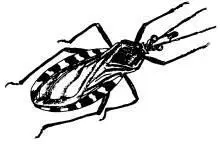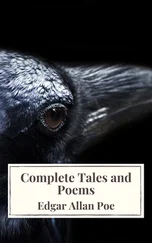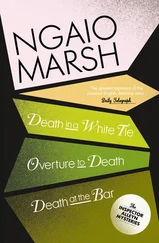
Figure 3.
Triatoma infestans.
Barbeiros have six strong legs, an inch-long body covered with fragile, transparent wings, bulbous eyes, and a proboscis nested under its body that can extend downward to ingest blood from mammals, including humans. Brazilians call these triatomine insects barbeiros, from the Portuguese word for barber, indicating that these insects cut like a barberreferring not to the fact that barbers accidentally cut the face with razors but that they also practice bloodletting, done at the time for medical purposes. Barbeiros are scientifically classified as Triatoma infestans (see Figure 3).
Carlos Chagas observed that barbeiros are sensitive to light and during the day hide in cracks and crevices of walls and ceilings where they rest, copulate, and lay eggs, which are tiny, white, and ball-shaped. Barbeiros are considered vampire bugs; they become active at night, descend from nests, are drawn to warmth, and draw blood from animals and humans. Faces are attractive targets that barbeiros pierce with their needle-sharp proboscises. They inject anesthetic and anticoagulant fluids that enable them to leisurely ingest blood from unwary and tired victims. Sleepers sometimes awake and smash the barbeiros, exploding the blood on their bodies or other surfaces as the bugs sluggishly return to their nests. They are superb crawlers and can attack victims by crawling beneath mosquito netting or from inside mattresses.
People also refer to barbeiros (or vinchucas ) as “kissing bugs” because of their predilection for the face. Chagas called the resulting chagoma (carbuncle sore) from a bite beneath the eye Signo de Romaña and pointed this out as an important diagnostic indicator of acute Chagas’, discussed more in Chapter 4 (see Figure 4).

Figure 4.
Child with Romaña’s sign, a chagoma that occurs at the site of the bite from the vinchuca bug. This occurs during the acute phase in about one-fourth of those infected with T. cruzi. (Photograph from the Pan American Health Organization)
Barbeiros (vinchucas) are triatomines, with more than 100 species that are vectors of Trypanosoma cruzi. Triatoma infestans is the most widespread and effective species vector of T. cruzi in Bolivia, and Bolivians refer to it as vinchuca. Sometimes classified as reduviid bugs, barbeiros do not have the painful bite of other reduviids. Barbeiros have injector-needlelike snouts or noses that fold back under their bodies and protrude down, like half-opened jackknives, to pierce the victim’s skin. They can engorge more blood than their body weight, and when they defecate they can leave small blotches of tobacco-like stains on the skin. They need blood meals, one for each of five instar (life) stages, in which they transform from barely the size of a flea to that of a small cockroach. At the final, adult stage, they grow wings, copulate, lay eggs, and die. Rather simple in their needs, triatomine insects need only a place to hide during the day and mammals to feed on during the night. (See Chapter 4 and appendices for more on triatomines).
Lassance was infested with barbeiros because of its impoverished socioeconomic conditions and human intrusion into nearby forests. Triatomines were driven from their native habitats as railroads expanded. Crawling aboard railway cars, barbeiros followed westward expansion across Brazil. Many houses for humans were made of thatched roofs and adobe walls, with cracks, crevices, and cornices providing nesting sites for barbeiros. Carlos Chagas recognized the impact poverty has upon the spread of insects, parasites, and disease, something Walter Reed also had observed in regard to malaria.
Years earlier, Charles Darwin had also been fascinated by vinchucas, and it could be wondered if Darwin’s fascination augmented Chagas’ curiosity about these bugs. Both shared essential ingredients of successful fieldworkers, curiosity about certain creatures and how they relate to other creatures. It is likely that Carlos Chagas, like most classically trained biologists at the time, had read about vinchuca bugs in the Diary of the Beagle, written by Darwin on March 26, 1835:
We crossed the river of Luxan (Andean region of Mendoza)… At night I experienced an attack, & it deserves no less a name, of the Benchuca, the great black bug of the Pampas. It is most disgusting to feel soft wingless insects, about an inch long, crawling over ones body; before sucking they are quite thin, but afterwards round & bloated with blood, & in this state they are easily squashed. They are found in the Northern part of Chili & in Peru: one which I caught at Iquiqui was very empty; being placed on the table & though surrounded by people, if a finger was presented, its sucker was withdrawn, & the bold insect began to draw blood. It was curious to watch the change in size of the insects body in less than ten minutes. There was no pain felt.This one meal kept the insect fat for four months; In a fortnight, however, it was ready, if allowed, to suck more blood. (Darwin, in Keynes 1988:315)
Several years later, Darwin wrote in his zoology notebook at Edinburgh (1837-1839) a partial description of vinchucas in French, which I translate: “ Vinchucas or Benchucas. The individual wings can be (four) five lines [ lignes ] long and they fly.” Darwin had found this quote from an earlier description by the naturalist Azara (1809, I:208-9): “ La vinchuca [is] very annoying for those who travel from Mendoza to Buenos Aires… It is a beetle or scarab, whose body is oval and very flat, and who becomes fat like a grain of raisin, from the blood which he sucks. This insect only comes out at night. The individual wings can be five lines [lignes] and they fly, at least the large ones.” [5] 2. “La vinchuca incommode beaucoup ceux qui voyagent de Mendoza á BuenosAyres… C’est un escarbot ou scarabée, dont le corps est ovale e très-aplati, et qui devient gros comme un grain de raisin, du sang qu’il suce… Cet insect ne sort que de nuit; les individus ailés peuvent avoir cinq lignes de long, et volent; ce qui n’arrive pas aux petit.”
He was referring to the fact that vinchucas grow wings only at the adult, or fifth instar, stage.
Experimentally, Darwin allowed vinchucas to draw blood from his finger and marveled at the dexterity of their proboscises. Some scholars have interpreted this to suggest that he became infected with T. cruzi, which would explain his semidebilitated state five years after the Beagle landed. [6] 3. Concerning the debate whether Darwin had Chagas’ disease see Browne 1995:280; Keynes 1988:315; Goldstein 1989:586-601; and Woodruff 1965.
Several weeks after being bitten, Darwin wrote in his diary for April 9, 1835: “From this day till I reached Valparaiso, I was not very well & saw nothing & admired nothing” (Keynes 1988:323). Darwin reached Valparaiso on April 17. The incubation period corresponds to the lead time for acute Chagas’ disease, but nine days is relatively short for its duration.
A second indication is that several years after the vinchuca bite Darwin began suffering a complex of symptoms from an undiagnosed chronic illness. Chagas’ disease gradually develops into a chronic phase, what has been called an intricate lifelong minuet that is danced by the parasite and the host’s immune system (Goldstein 1989). This could explain Darwin’s illness: nonspecific symptoms of increased parasitemia such as malaise, fever, fatigue, and decreased energy when the immune system was down. Advancing age, periodic illnesses, psychological stress, and exhaustion could certainly have weakened Darwin’s immune system, which was necessary to keep T. cruzi at bay.
Читать дальше














